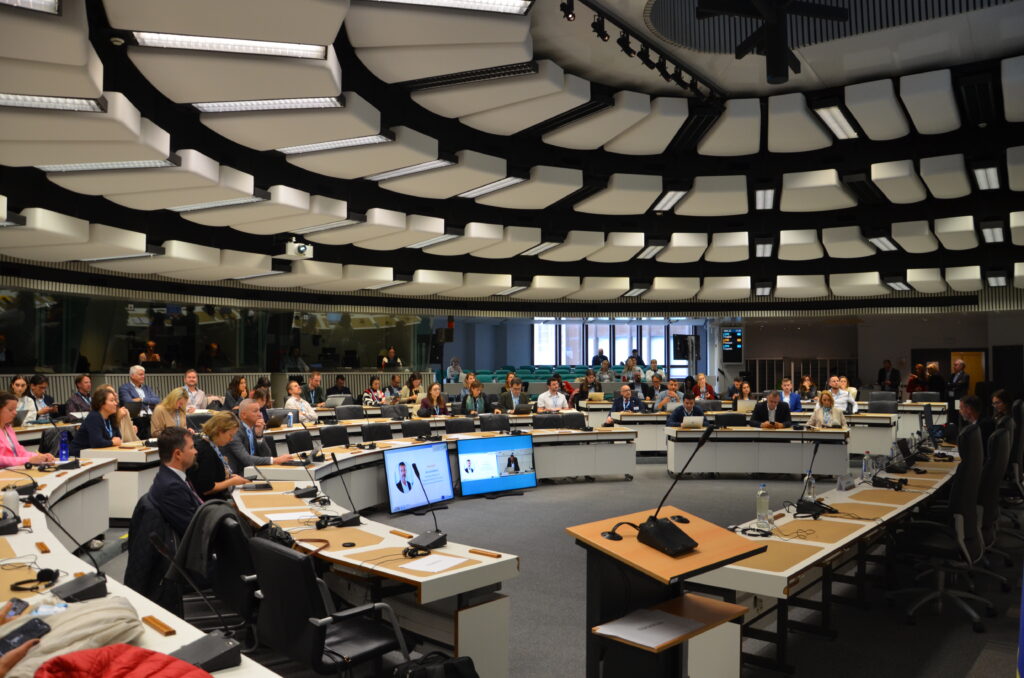On Wednesday 15 October 2025, local and regional leaders, innovation practitioners and policy-makers gathered under the banner of the 2025 edition of the Digital Assembly.
The theme – Empowering Cities and Regions through Data and People-Centred Digitalisation – set the tone for an urgent and candid discussion: how can cities and regions lead on digital transformation, harness the potential of artificial intelligence (AI) and data, while safeguarding inclusivity, trust and local benefit?
Across the session, several keynote contributions illuminated the path ahead and highlighted the gaps we still need to bridge. Below we summarise the key messages, emerging priorities and next-steps that the Living-in.EU Movement should champion.
The 2025 Living-in.EU Digital Assembly was opened by the two co-chairs: Ivan Goychev, Deputy Mayor for Digitalisation, Innovation, and Economic Development of the city of Sofia, Bulgaria, and Lluïsa Moret, President of the Barcelona Provincial Council and Mayor of Sant Boi de Llobregat, Spain.
Their opening remarks set the tone for a session focused on how local and regional leaders can drive Europe’s digital transformation through collaboration, trust, and a shared commitment to people-centred innovation. Both underlined that cities are at the heart of Europe’s digital future: close to citizens, aware of their needs, and capable of turning policy ambition into real-world impact.
The Assembly featured a rich exchange among representatives from the European Commission, city administrations and innovation practitioners, all converging on a shared message: Europe must be bold, collaborative, and people-centred in its digital transformation.
Martin Bailey from the European Commission opened the discussion by emphasising that Europe needs to overcome its lingering apprehension about artificial intelligence. The EU, he noted, has at times fallen behind because many companies have been reluctant to invest in AI, while global competitors seized opportunities. To reverse this trend, cities and regions must take a leading role — not just managing risks but actively embracing the transformative potential of AI. While the Commission continues to provide significant support, Bailey highlighted the need for stronger local engagement: cities require access to the right tools and an enabling environment to harness AI effectively. He called for a closer nexus between public authorities, businesses, and academia to build self-sustaining, applied-AI strategies — beyond reliance on EU funding. This, he said, should go hand-in-hand with creating a marketplace for AI applications that can be scaled and adapted to local needs.
From a city perspective, Ivan Goychev, Deputy Mayor of Sofia, illustrated how open data can empower citizens and spark innovation. He recounted a simple yet powerful example: within three days of releasing public-transport data, a citizen had already built a map to support police outreach. This, he argued, demonstrates that cities do not need to solve every problem themselves, their mission is to provide the platforms, the data and the enabling conditions for citizens to act. Yet, not all municipalities currently have the capacity to open their data or maintain such platforms, which remains a critical challenge.
Amalia Vrachnou, Deputy Mayor of of Urban Resilience and Regeneration of Kifissia, added that modernising public services also means making them more transparent and participatory. In her city, digital systems now allow citizens to submit and track service requests, revealing bottlenecks and improving accountability. She underlined the importance of interoperability between systems, co-design processes that include students and citizens, and collaboration between academia and business. Her city’s work on sustainable mobility — developing Greece’s largest cycling network, new pedestrian routes and geolocation-based services — shows how data can guide tangible improvements in daily life, while internal digital-skills training ensures that public employees keep pace with innovation.
Jan Wester, Director LDT CitiVERSE EDIC, reminded participants that the technology is largely available: the challenge is to connect it meaningfully. Virtual tools and platforms must be integrated to create real value. He stressed that cities and regions need to collaborate across levels of governance, linking living labs and testbeds, blending skills and involving private partners in a framework of trust. Scaling innovation, he argued, will be impossible without public-private partnerships built on clear expectations, ethical principles and a shared commitment to the public interest. Cities, for their part, must “do their homework”: define how they want to be served, what outcomes they expect, and how technology can best enhance citizens’ lives.
From the rich discussion emerged several clear priority areas:
As the political advisory body of the Movement, the Digital Assembly reinforced the call for local and regional voices to be central to European digital & green transitions.
For the Living-in.EU community—and in particular the ecosystem of living labs, cities, regions and industry partners aligned through ENoLL—this means:
The Digital Assembly brought into sharp relief both the tremendous opportunity and the significant challenge ahead. European cities and regions can become leaders in a data- and AI-enabled future — but only if they are empowered, connected, trusted and equipped. When citizens are at the centre, when data is opened responsibly, when platforms are interoperable, and when business, academia and public sector align — then we will see digital transformation that truly serves people and place.
As part of the Living-in.EU Movement, we are well placed to support this journey: through networks, living labs, good practice sharing and advocacy. Let us embrace the future, act together, and ensure that cities and regions across Europe can harness data and AI to build thriving, resilient and inclusive communities.
Thank you to all participants, to our speakers and to the entire network for making the 2025 Digital Assembly a platform for progress.
We look forward to engaging further – and to the many collaborations that will follow.
You can watch the recording of the Digital Assembly here.


